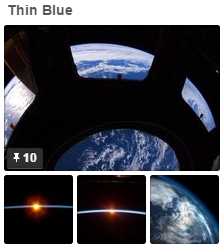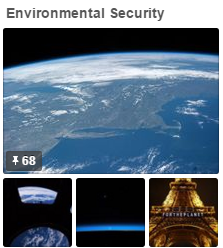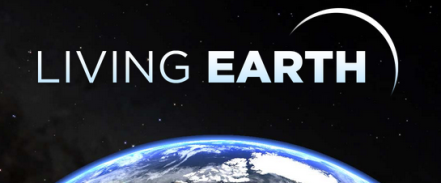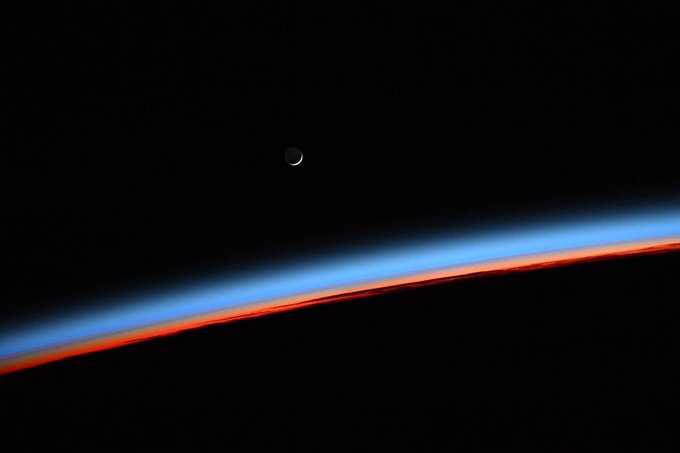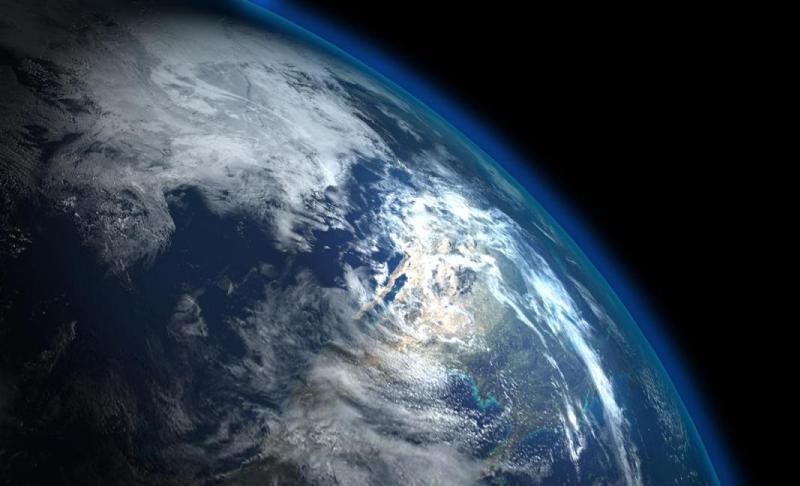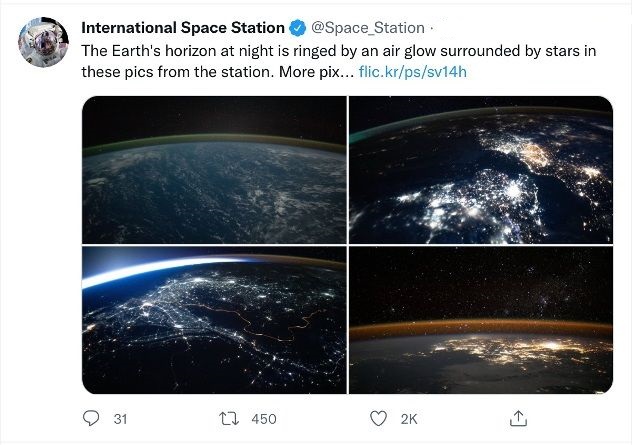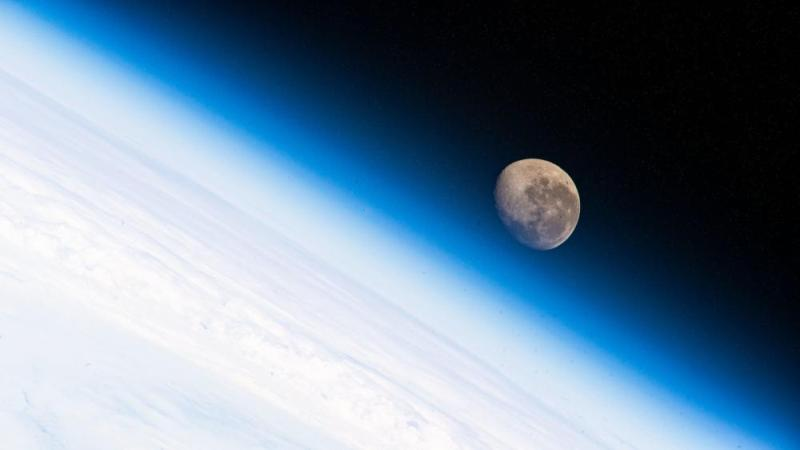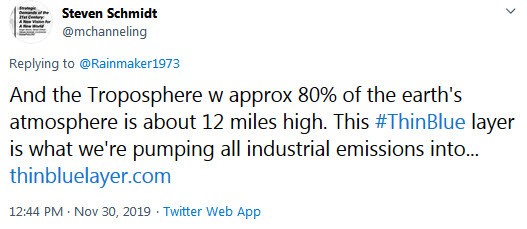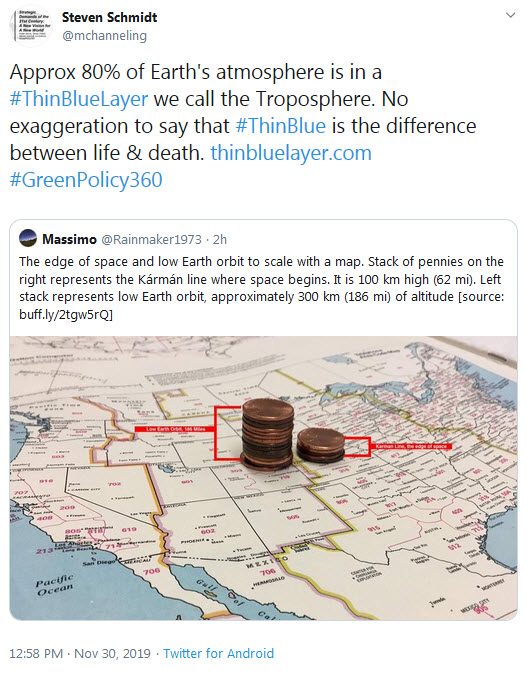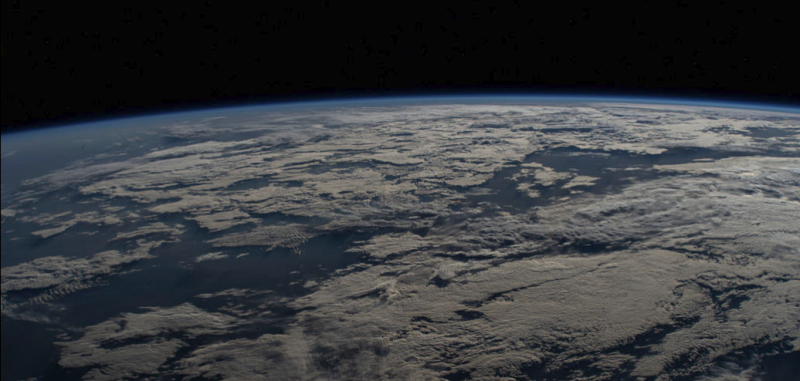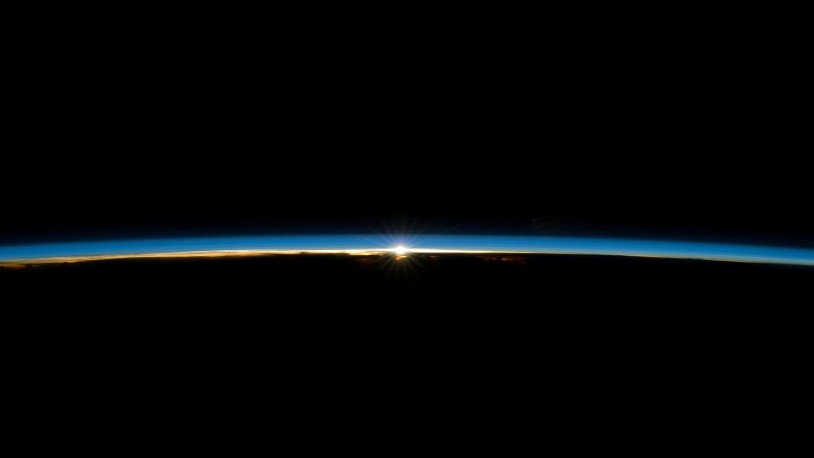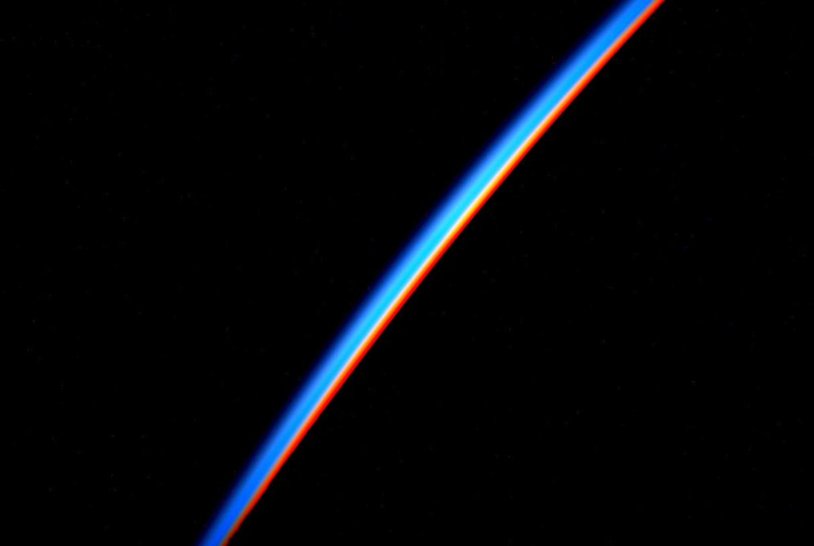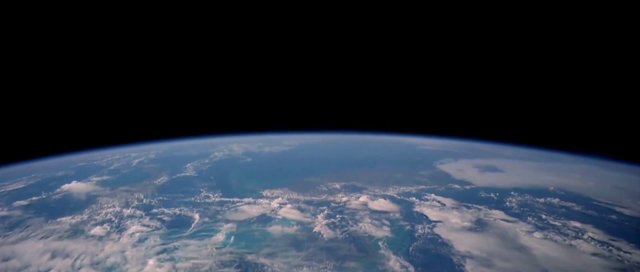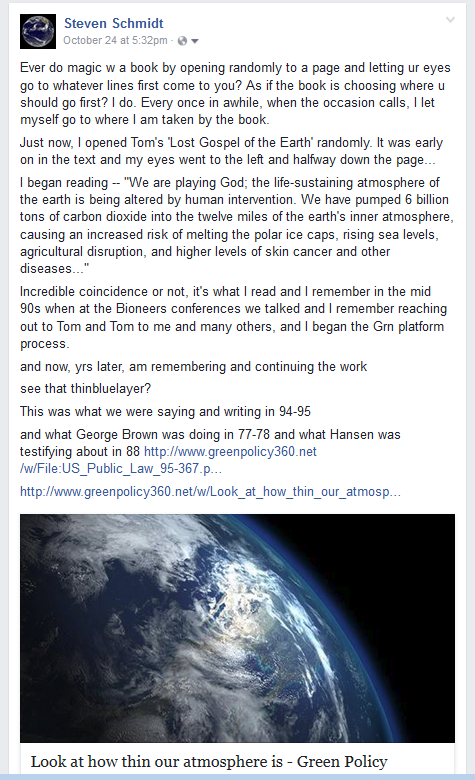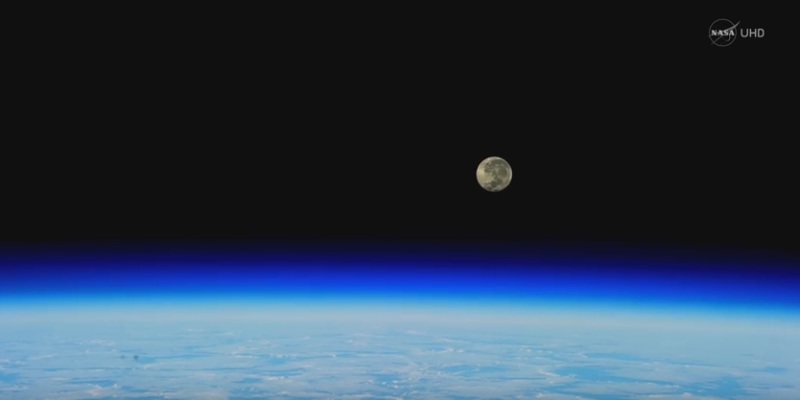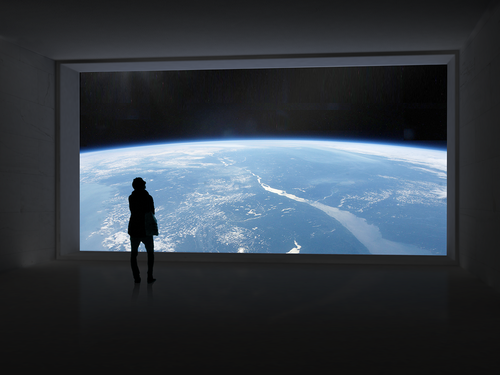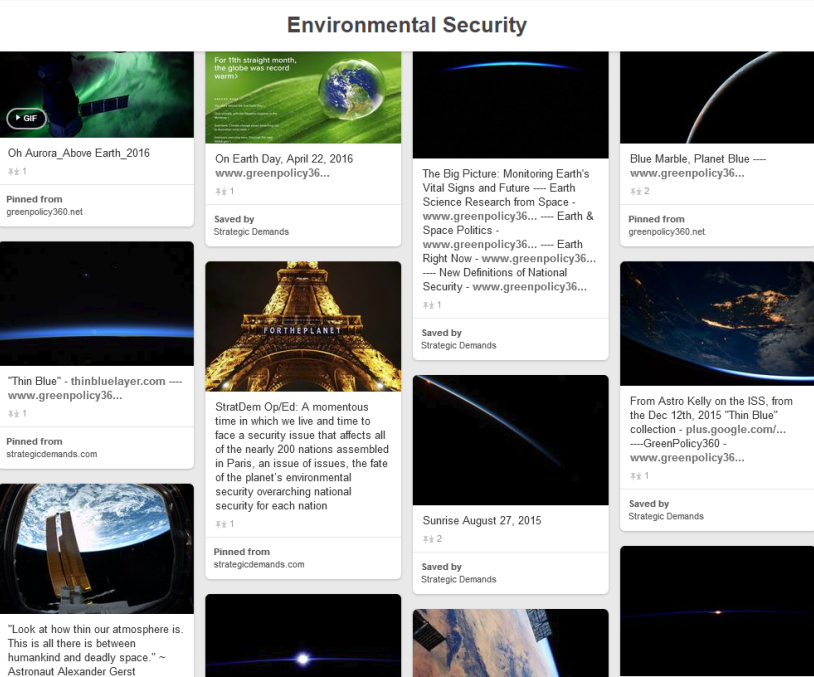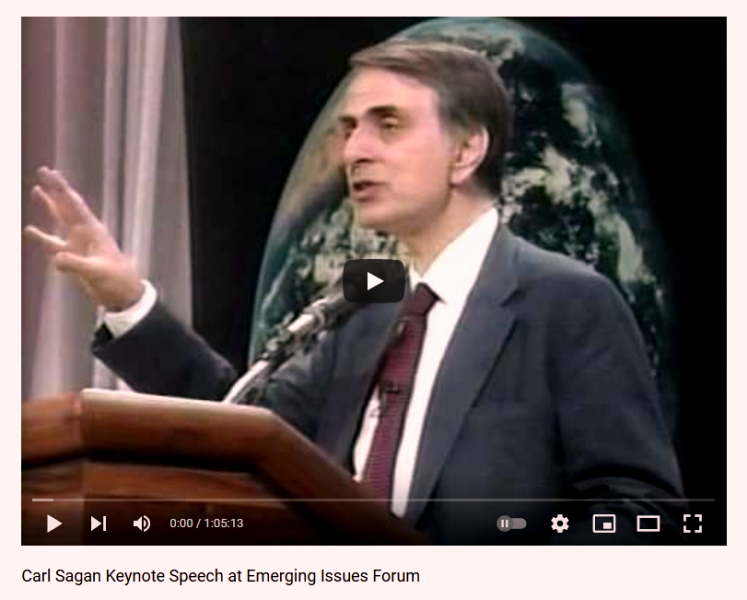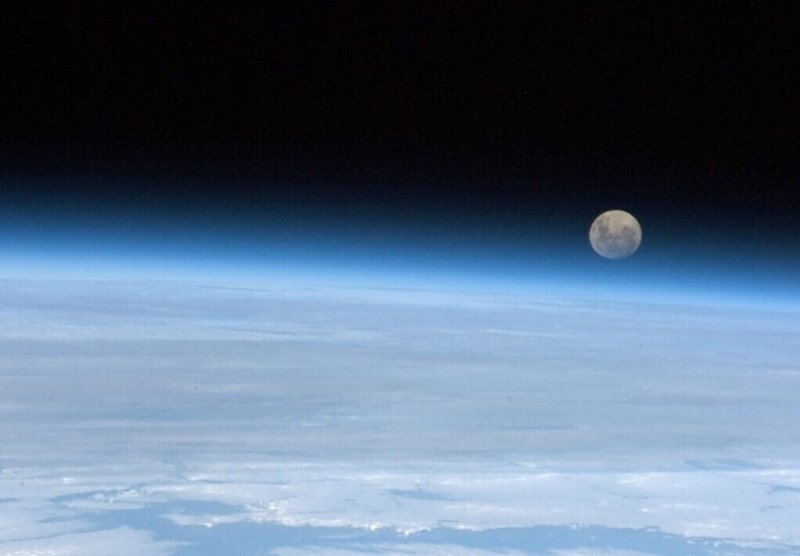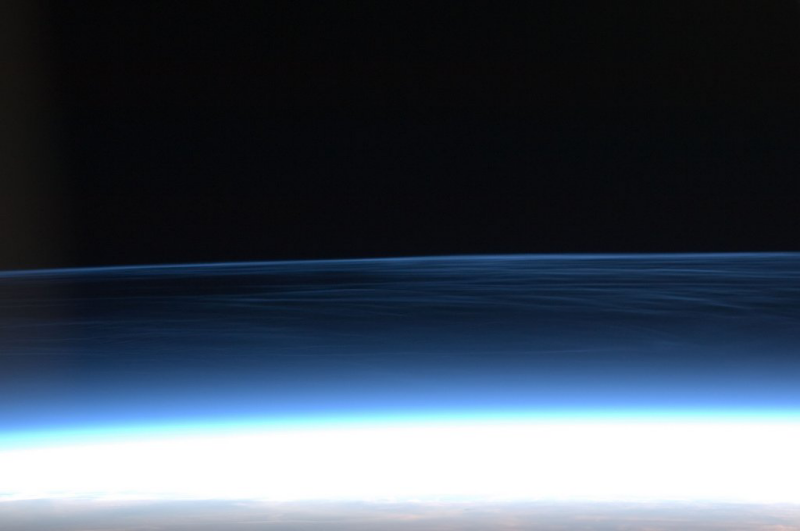Look at how thin our atmosphere is
NASA
What we at GreenPolicy360 call a "Thin Blue Layer" is, measurably, approximately 80% of Planet Earth's atmosphere, and is responsible for creating conditions making possible our Living Earth and... This "Thin Blue" is only about "12 miles high"...
- As Planet Citizens together, we have the responsibility to protect & secure "Thin Blue"
- NASA
- ○ ○ ○ ○ ○ ○ ○ ○ ○ ○ ○ ○
- Dawn from Space
- Thin blue line
- Mysterious rhythm
- Our next breath
- Heart struck with wonder
- Mind dizzy with awe
- -- Astronaut Douglas Wheelock @Astro_Wheels
- "Look at how thin our atmosphere is. This is all there is between humankind and deadly space."
- -- Astronaut Alexander Gerst @Astro_Alex
- "Thin Blue"
- Our goal: To protect & preserve Earth's thin layer of life-enabling atmosphere
Thin Blue Layer of Global Security
- "Thin Blue" -- Global Commons, Global Trust
"It is all connected, it is all interdependent...
You look out the window, and in my case, I saw the thinness of the atmosphere, and it really hit home, and I thought, 'Wow, this is a fragile ball of life that we're living on.'
It is hard for you to appreciate that until you are outside of it." - Astronaut Sandra Magnus
Strategic Demands: New Definitions of National and Environmental Security
ESA
NASA
🌎
Up & Back: A Blue Origin's Moment in Time
July 2021 as Jeff Bezos returns to Earth from his journey up to the edge of space on the Blue Origin ship... he speaks emotionally of how thin the atmosphere is...
“When you get up above it, what you see is, it’s actually incredibly thin. It’s this tiny, little fragile thing, and as we move about the planet, we’re damaging it. That’s a very profound — it’s one thing to recognize that intellectually. It’s another thing to actually see with your eyes how fragile it really is.”
Yes, from Jeff Bezos' eyes and lips to our ears and our realization of what is at risk... of how our generation has a great challenge and task we must take on...
"We are beginning to realize the extent of an existential experiment humanity is conducting in the atmosphere of the planet, the "thin blue layer". The Anthropocene era is a gathering storm that is changing 'nature' as nature used to be... Our challenge is to use our native intelligence to protect the life-enabling atmosphere, to make decisions that sustain and benefit life today and for future generations." -- Steven J. Schmidt
SJS / GreenPolicy360 Siterunner:
Perspective of Earth's atmosphere from an Astronaut's point of view, the thinness of the Earth’s life-supporting envelope, is clear to see when up above the atmosphere. Yet, from the surface of the Earth, looking up, it is not clear at all how far the atmosphere goes. It is not clear how this 'thin blue' layer acts to protect our planetary ecosystems, our biosphere.
A collapse of the biosphere due to anthropogenic climate change is not an impossible scenario when seen with an overview perspective. The words of astronauts speaking of the thin layer of Earth's protective atmosphere are as if modern Cassandra voice are warning without being heard or listened to by those too busy to hear...
Let's talk in common language then, the language of cars and these cars are being driven up into the sky, not on highways to work or play. How far is it before we reach the edge of 'the sky', the border to life as we know it down here on Earth?
How can kids in schools learn that the sky, the atmosphere above us, the 'thin blue layer' that protects life on Earth, is at risk and needs to be carefully taken care of and preserved.
Our generation and generations to come must know and learn "Earth is in our hands and our planet's health is in our care..."
Most all of the atmosphere of Earth is compacted into what is called the Troposphere. What is the height, the extent of the atmosphere?
The sky is just a few miles high. Look how thin our atmosphere is...
🌎
Driving Up There, From Down Here
NASA
Troposphere - https://en.wikipedia.org/wiki/Troposphere
- Stratosphere - https://en.wikipedia.org/wiki/Stratosphere
- Kármán line - https://en.wikipedia.org/wiki/K%C3%A1rm%C3%A1n_line
- Earth's Atmospheric Layers - https://www.nasa.gov/mission_pages/sunearth/science/atmosphere-layers2.html
The Earth's atmosphere does not abruptly end at any given height but becomes progressively thinner with altitude. The edge of most all of the atmosphere (80% approximately in the Troposphere) is not far above us.
The troposphere is one of five layers of the atmosphere surrounding the earth. The other four layers include the stratosphere, mesosphere, thermosphere, and exosphere. The troposphere is the lowest layer of the atmosphere, closest to the earth's surface. Its depth is different at different regions of the earth, being deeper in the warmer regions and shallower in the colder regions. The word 'troposphere' is derived from the Greek word 'Tropos' which means 'change'.
The troposphere is located closest to the earth, followed by the stratosphere, mesosphere, thermosphere, and the exosphere. The troposphere contains approximately 80% of the mass of the atmosphere of the Earth and 99% of the total mass of Earth's atmospheric water vapor.
The transitional area between the troposphere and stratosphere is called the tropopause. The jet stream or 'river of air' as it is also referred to, is located just below the tropopause and moves at approximately 250 miles per hour. The troposphere extends from the earth's surface to approximately 33,000 feet (6.2 miles) high. However in warm regions like the equator it can rise as high as 65,000 feet (12 miles). In colder regions like the north and south poles, it may rise only as high as 23,000 feet (4 miles). The troposphere is not heated directly from the sun. Instead, the sun heats the ground and the ocean and this heat is then radiated into the troposphere.
Despite the fact that only a small percentage of the troposphere's gas is carbon dioxide, this is the determining factor in the earth's temperature...
20 kilometers = 12.42742 miles
25 kilometers = 15.53428 miles
30 kilometers = 18.64114 miles
NASA
- NASA
“For the first time in my life, I saw the horizon as a curved line. It was accentuated by a thin seam of dark blue light: the atmosphere...”
- “This was not the ‘ocean’ of air I had been told it was ... I was terrified by its fragile appearance.” -- Astronaut Merbold
NASA
Astronaut Gerst: “Some things that on Earth we see in the news every day and thus almost tend to accept as a “given”, appear very different from our perspective.”
- “We do not see any borders from space. We just see a unique planet with a thin, fragile atmosphere, suspended in a vast and hostile darkness.”
- “From up here it is crystal clear that on Earth we are one humanity.”
- NASA
One of the earliest known experiences of space travel, a whole earth perspective shared by returning astronauts, is what author Frank White calls an “Overview Effect”
○ ○ ○ ○ ○ ○ ○ ○ ○ ○
NASA
"An Experiment of Epic Scale"
Anthropogenic Change of Our Atmosphere
Atmosphere of Earth - Wiki / Isn't It About Time We Measure the Dynamic Changes in the Atmosphere?
We are in the first era of geo-monitoring the thin blue atmosphere, earth systems and biosphere from space ...
NASA
- Beginning w/ first-ever images of our home planet in the Apollo era...
- NASA
First-generation #EarthObservations
An #EarthPOV, an "Overview" that, over time, will educate #PlanetCitizens to new challenges
Our generation, each generation, faces new possibilities and challenges as citizens of the planet ...
○ ○ ○ ○ ○ ○ ○ ○ ○ ○ ○ ○ ○ ○ ○
NASA
Steven Schmidt / GP360 Siterunner: "A chemical experiment with unknown consequences is taking place above and around us. The Earth's atmosphere, a thin layer that enables and protects life, is being impacted by potentially deadly human-produced emissions, even as a first generation of data and science is being produced with atmospheric observations from space. We are beginning to realize the extent of an existential experiment humanity is conducting in the atmosphere of the planet. The Anthropocene era is a gathering storm that is changing 'nature' and our responsibility to future generations is profound."
○
Elon Musk: "The greater the change to the chemical composition of the physical, chemical makeup of the oceans and atmosphere (due to increased carbon emissions), the greater the long-term effect will be... Why would you run this crazy experiment to see how bad it'll be? We know it's at least some bad, and the overwhelming scientific consensus is that it'll be really bad."
“Even if you put the environmental consequences of dramatically changing the chemical composition of the oceans and atmosphere aside, we will eventually run out of oil. If we don’t find a solution to burning oil for transport, and we then run out of oil, the economy will collapse and civilization will come to an end as we know it. And so if we know that we have to ultimately get off oil no matter what — we know that is an inescapable outcome, it’s simply a question of when, not if — then, why would you run this crazy experiment of changing the chemical composition of the atmosphere and oceans by adding enormous amounts of CO2 that’ve been buried since the pre-Cambrian era? That’s crazy. That is the dumbest experiment in history, by far. Can you think of a dumber experiment? I honestly cannot. What good could possibly come of it?”
-- Elon Musk Interviewed by Neil DeGrasse Tyson’s in 'Star Talk' '
The "thin blue" layer... absorbing the sum of human-produced emissions...
- Today's generation begins to measure and calculate the cost of "externalities"
NASA
A New Vision of Security
Looking Up to See a "Thin Blue" Challenge of the 21st Century
The high ground, the atmosphere, atmospheric and earth science being developed by a first generation of environmental, planet scientists
The 'thin blue layer' is a common ground, a necessary, vital, existential space that must be protected for our common survival
- A "paradigm", new vision and new strategies to define and act upon national security needs and challenges
- An endeavor of GreenPolicy360 and StrategicDemands in the national security space
Existential Threat Horizon
As planet citizens we must acknowledge and measure our impact on natural systems of Earth
The Challenge of Acting for the Commons
NASA
Tags: #Atmospheric Science; #ClimatePolicy; #Environmental Security; #PlanetCitizen; #Sustainability Policies; #ThinBlueLayer
NASA
- Anthropocene
- Atmosphere
- Atmospheric Science
- Citizen Science
- Climate Policy
- Democratization of Space
- EOS eco Operating System
- Earth Imaging
- Earth Observations
- Earth Science
- Earth Science from Space
- Earth System Science
- EarthPOV
- Earth360
- Ecology Studies
- Eco-nomics
- Education
- Environmental Full-cost Accounting
- Environmental Security
- Environmental Security, National Security
- ESA
- Global Security
- Global Warming
- Green Politics
- ISS
- NASA
- Natural Resources
- Networking
- New Definitions of National Security
- New Space
- NOAA
- Overview Effect
- Planet Citizen
- Planet Citizens
- Planet Scientist
- Planet Citizens, Planet Scientists
- Resilience
- Seventh Generation Sustainability
- Strategic Demands
- ThinBlueLayer
- Threat Multiplier
- US Environmental Protection Agency
- Whole Earth
- Biogeosciences
- Climate Change
- Cryosphere
- Forests
- Geophysics and Geochemistry
- Mineralogy
- Geology
- Geophysics
- Hydrology
- Oceans
- Ocean Science
- Planetary Science
- Space Science and Space Physics


